
|
Among the methods covered in this volume, HDD involving the use of drilling fluid is the most common method for the trenchless installation of pipelines. In all cases a fluid serves for removing spoil. In (Drilling fluid) the tasks of drilling fluid are described in detail [HDD-14] [HDD-15] [HDD-16]. |

|
HDD methods require the use of drilling fluids. Drilling fluids refer to the controlled circulation of fluids in the borehole or in the conveying circuit and include fluids, gasses or a mixture of the two. Drilling fluids with gas play only a minor role in the trenchless installation of pipes and cables - only being applied in Dry Horizontal Directional Drilling (Dry HDD) (see (Dry Horizontal Directional Drilling)). This is why, in the following, … |

|
The task of the drilling fluid in its function as support fluid in HDD is in the support of the borehole wall, of the working face against the earth pressure, and in groundwater saturated soils against the in-situ water pressure. It hinders the uncontrolled collapse of the surrounding ground or the ingress of plastic soils or of groundwater into the borehole. This is achieved by applying appropriate pressure to the drilling fluid, which must be maintained … |

|
(Image: Hydraulic transport of solids in horizontal direction)The role of the drilling fluid in terms of acting as a transport fluid in HDD is (cf. Table 37), on the one hand, to keep the boring tools and the borehole wall free of loosened spoil. On the other hand, it is intended to transport spoil hydraulically to the surface in a floating manner through the annular space between drill rod and borehole wall. With hydraulic conveyors, the transport … |

|
In the following, the demands, properties and application areas of water-based fluids with or without solids, which are used in HDD, as well as the additives used for an aimed influence of certain fluid properties will be presented. When choosing the drilling fluid for the respective case of application, the geological and hydrogeological conditions described in the geotechnical report (see (Geotechnical investigations) and Volume 1, Section 4.5 [… |

|
The simplest drilling fluid is water. Without additives (clear water drilling fluid), in HDD it is rarely used as a solid-free drilling fluid, since water lacks the bearing capacity, which is provided by viscosity and gel strength and which is necessary for cleaning the borehole invert and especially for removing the spoil. Water is cheap, easily available from local water supply systems, stagnant or flowing waters, or from groundwater and can usually … |

|
Water is the most important basic material for producing drilling fluids and can form the base for a suitable drilling fluid with solids content whose properties can be adapted to the application conditions or tasks in accordance with Table 37. Thus, fluid admixtures can be created using so-called structure formers (solids structure formers such as bentonite and fluid structure formers such as polymers) and additives such as inert solids or organic … |

|
|

|
Bentonite is one of the most important solid structure formers in connection with drilling fluids. The naturally occurring swelling clay was first discovered in Fort Benton in Wyoming, USA in 1898. The main component of bentonite is the clay mineral Montmorillonite, a layered aluminium hydrosilicate that greatly determines the physical and chemical properties of bentonite [HDD-209] [HDD-210] [HDD-211]. Deposits of bentonite are spread throughout the … |

|
(Image: Filtration of drilling fluid by bentonite platelets entering the pores of the borehole wall)Stability is a suspension’s property not to separate further or to separate very little over time (Figure 150 a). If the components separate themselves, it is referred to as an unstable suspension. Stable suspensions do not separate by themselves but the components of the suspension can be separated by mechanical and/or chemical agents (see (Preparation … |

|
The density ( is a physical parameter and is defined as the relation of the mass m in a substance to its volume V. In this application case, together with the viscosity and the flow velocity, it determines the possible transport capacity of the drilling fluid (cf. (Flow velocity and transport capacity)). It is determined with the aid of a specially configured scale (fluid density scale) or by weighing a known volume. According to this latter method, … |

|
DIN 1342-1 [HDD-218] defines viscosity as the property of a substance (primary terminology for gases, fluids and solids) to flow under the effects of a stress and to be irreversibly deformed. In this process, the flow energy is converted to heat. In the case at hand, in a simplified way viscosity η, measured in [mPa • s], is understood to be the resistance of fluids to relative motion. According to DIN 1342-2 [HDD-218], it is characterised as the … |

|
The yield point τF of a material is understood as its property of being able to take up shear stress τ up to a maximum value without plastic deformation (flow) occurring. For an ideal plastic material or an ideal plastic fluid applies [HDD-204]: a) for τ < τF no plastic deformation
b) for τ = τF unlimited plastic deformation (flow). The yield point τF according to DIN 4127 [HDD-219], is the shear stress at which flow takes place. It depends on the … |

|
(Image: Shearometer experiment to test gel strength)Gel strength (short: GS, measured in g/cm2) is referred to as the stability of the lattice structures of the structure forming agents. It is a quantity for defining the thrixotropic behaviour of a suspension and grows over time by thixotropic hardening. It also tends to increase with the concentration of bentonite or clay [HDD-14]. Directly after completing intensive stirring, if that destroyed the … |

|
Sand is usually understood to be all solids > 63 μm (Germany) or 74 μm (USA) contained in a drilling fluid irrespective of the mineralogical composition. Also solids < 63 μm or 74 μm act in an eroding and fluidharming way, so that possibly also the concentration of this particle size range has to be determined [HDD-14]. The above mentioned 74 μm or 74 Microns corresponds to a 200 Mesh, which represent the smallest mesh width of the screen panels in … |

|
Bentonite suspensions are used in coarse particle, loose to densely stratified sands or gravels, uneven and inhomogeneous soils with water permeability coefficients of k > 10-3 m/s [HDD-198] [HDD-237]. Pure Bentonite suspensions find their limits of application, on the one hand, in coarse particle soils with open structures such as even shaped coarse gravels and, on the other hand, in pure clay soils. In the latter, because of the absence of inhibiting … |

|
Bentonite is one of the most important solid structure formers in connection with drilling fluids. The naturally occurring swelling clay was first discovered in Fort Benton in Wyoming, USA in 1898. The main component of bentonite is the clay mineral Montmorillonite, a layered aluminium hydrosilicate that greatly determines the physical and chemical properties of bentonite [HDD-209] [HDD-210] [HDD-211]. Deposits of bentonite are spread throughout the … |

|
Polymer drilling fluids are solid-free fluids, in which so-called “fluid structure formers” are added to the water in the form of strongly hydrophilic polymers. Polymers are chemical compounds in which numerous basic molecules of the same or similar type are tightly bound to each other. They are created by an ordered linking of single molecules (monomers) into a chain or macro-molecule (polymerisation). The most important type of linkage is the carbon-… |
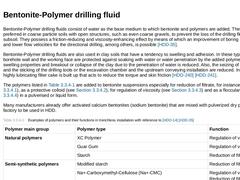
|
Bentonite-Polymer drilling fluids consist of water as the base medium to which bentonite and polymers are added. They are preferred in coarse particle soils with open structures, such as even coarse gravels, to prevent the loss of the drilling fluid into the subsoil. They possess a friction-reducing and viscosity-enhancing effect by means of which an improvement of boring is achieved and lower flow velocities for the directional drilling, among others, … |

|
Reduction of filtrate in drilling fluid is understood to be the reduction of the fluid quantity filtering into the subsoil - the reduction of filtrate being due to the formation of a very thin, dense ductile and elastic sealing filter cake (see (Stability)) [HDD-14]. In order to achieve this reduction of filtrate, so-called filtrate reducers based on polymers are used. They consist of macromolecules that are sheathed with a fixed adhesive hydrate … |
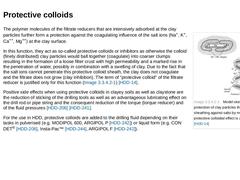
|
(Image: Model sketch of the protection of clay particles through polymer sheathing against salts by means of which protective colloidial effect is achieved)The polymer molecules of the filtrate reducers that are intensively adsorbed at the clay particles further form a protection against the coagulating influence of the salt ions (Na+, K+, Ca++, Mg++) at the clay surface. In this function, they act as so-called protective colloids or inhibitors as … |
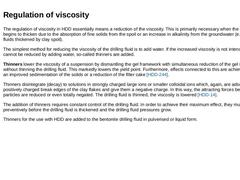
|
The regulation of viscosity in HDD essentially means a reduction of the viscosity. This is primarily necessary when the drilling fluid begins to thicken due to the absorption of fine solids from the spoil or an increase in alkalinity from the groundwater (e.g. drilling fluids thickened by clay spoil). The simplest method for reducing the viscosity of the drilling fluid is to add water. If the increased viscosity is not intended to or cannot be reduced … |
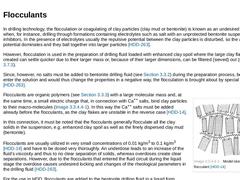
|
In drilling technology, the flocculation or coagulating of clay particles (clay mud or bentonite) is known as an undesired phenomenon when, for instance, drilling through formations containing electrolytes such as salt with an unprotected bentonite suspension without inhibitors. In the presence of electrolytes usually the repulsive potential between the clay particles is disturbed, so the attractive potential dominates and they ball together into … |
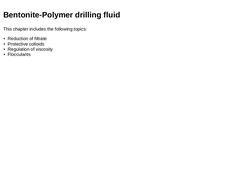
|
Bentonite-Polymer drilling fluids consist of water as the base medium to which bentonite and polymers are added. They are preferred in coarse particle soils with open structures, such as even coarse gravels, to prevent the loss of the drilling fluid into the subsoil. They possess a friction-reducing and viscosity-enhancing effect by means of which an improvement of boring is achieved and lower flow velocities for the directional drilling, among others, … |
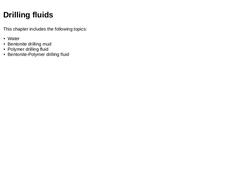
|
In the following, the demands, properties and application areas of water-based fluids with or without solids, which are used in HDD, as well as the additives used for an aimed influence of certain fluid properties will be presented. When choosing the drilling fluid for the respective case of application, the geological and hydrogeological conditions described in the geotechnical report (see (Geotechnical investigations) and Volume 1, Section 4.5 [… |